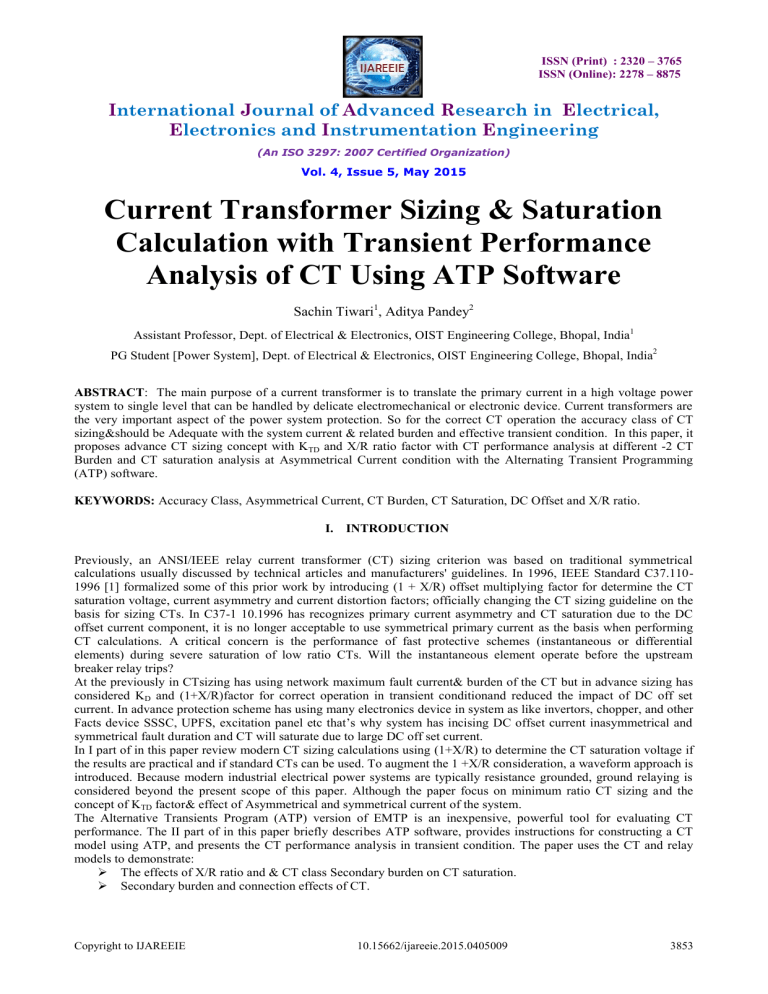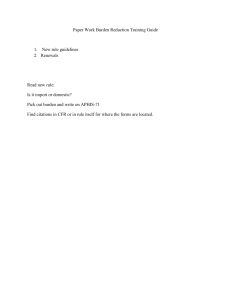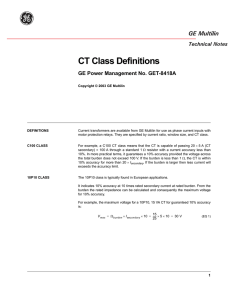
ISSN (Print) : 2320 – 3765
ISSN (Online): 2278 – 8875
International Journal of Advanced Research in Electrical,
Electronics and Instrumentation Engineering
(An ISO 3297: 2007 Certified Organization)
Vol. 4, Issue 5, May 2015
Current Transformer Sizing & Saturation
Calculation with Transient Performance
Analysis of CT Using ATP Software
Sachin Tiwari1, Aditya Pandey2
Assistant Professor, Dept. of Electrical & Electronics, OIST Engineering College, Bhopal, India1
PG Student [Power System], Dept. of Electrical & Electronics, OIST Engineering College, Bhopal, India2
ABSTRACT: The main purpose of a current transformer is to translate the primary current in a high voltage power
system to single level that can be handled by delicate electromechanical or electronic device. Current transformers are
the very important aspect of the power system protection. So for the correct CT operation the accuracy class of CT
sizing&should be Adequate with the system current & related burden and effective transient condition. In this paper, it
proposes advance CT sizing concept with KTD and X/R ratio factor with CT performance analysis at different -2 CT
Burden and CT saturation analysis at Asymmetrical Current condition with the Alternating Transient Programming
(ATP) software.
KEYWORDS: Accuracy Class, Asymmetrical Current, CT Burden, CT Saturation, DC Offset and X/R ratio.
I. INTRODUCTION
Previously, an ANSI/IEEE relay current transformer (CT) sizing criterion was based on traditional symmetrical
calculations usually discussed by technical articles and manufacturers' guidelines. In 1996, IEEE Standard C37.1101996 [1] formalized some of this prior work by introducing (1 + X/R) offset multiplying factor for determine the CT
saturation voltage, current asymmetry and current distortion factors; officially changing the CT sizing guideline on the
basis for sizing CTs. In C37-1 10.1996 has recognizes primary current asymmetry and CT saturation due to the DC
offset current component, it is no longer acceptable to use symmetrical primary current as the basis when performing
CT calculations. A critical concern is the performance of fast protective schemes (instantaneous or differential
elements) during severe saturation of low ratio CTs. Will the instantaneous element operate before the upstream
breaker relay trips?
At the previously in CTsizing has using network maximum fault current& burden of the CT but in advance sizing has
considered KD and (1+X/R)factor for correct operation in transient conditionand reduced the impact of DC off set
current. In advance protection scheme has using many electronics device in system as like invertors, chopper, and other
Facts device SSSC, UPFS, excitation panel etc that’s why system has incising DC offset current inasymmetrical and
symmetrical fault duration and CT will saturate due to large DC off set current.
In I part of in this paper review modern CT sizing calculations using (1+X/R) to determine the CT saturation voltage if
the results are practical and if standard CTs can be used. To augment the 1 +X/R consideration, a waveform approach is
introduced. Because modern industrial electrical power systems are typically resistance grounded, ground relaying is
considered beyond the present scope of this paper. Although the paper focus on minimum ratio CT sizing and the
concept of KTD factor& effect of Asymmetrical and symmetrical current of the system.
The Alternative Transients Program (ATP) version of EMTP is an inexpensive, powerful tool for evaluating CT
performance. The II part of in this paper briefly describes ATP software, provides instructions for constructing a CT
model using ATP, and presents the CT performance analysis in transient condition. The paper uses the CT and relay
models to demonstrate:
The effects of X/R ratio and & CT class Secondary burden on CT saturation.
Secondary burden and connection effects of CT.
Copyright to IJAREEIE
10.15662/ijareeie.2015.0405009
3853
ISSN (Print) : 2320 – 3765
ISSN (Online): 2278 – 8875
International Journal of Advanced Research in Electrical,
Electronics and Instrumentation Engineering
(An ISO 3297: 2007 Certified Organization)
Vol. 4, Issue 5, May 2015
II. THE CONCERNS
Fig. 1 Equivalent circuit diagram Current Transformer
In Fig. 1 has show the equivalent circuit of a current transformer with load impedance and details of parameter in CT.
Basic working principle of the CT is same as the traditional transformer so no more difference in CT equivalent circuit
as compare to traditional transformer. As show in fig 1 the CT secondary voltage V S not should be saturate and exciting
current should be low for better protection & measurement. When the voltage developed across the ct burden is low,
the exciting current is low. The waveform of the secondary current will contain no appreciable distortion. As the
voltage across the ct secondary winding increases because either the current or the burden is increased, the flux in the ct
core will also increase. Eventually the ct will operate in the region where there is a disproportionate increase in exciting
current. The ct core is entering the magnetically saturated region; operation beyond this point will result in an
increasing ratio error and a distorted secondary current waveform.
III. CALCIFICATION OF CT ACCORDING TO PROTECTION SYSTEM
1. PS Class CT – This type of ct is use for where the current balance is precisely required to be maintained. In the
Overall differential protection, Transformer, Generator protection needs PS class CT. The developed voltage in ct core
is less than the knee voltage of the CTs.
2. PROTECTION CLASS CT – They are used for over current & instantaneous & IDMT Relay. As like 5P10, 5P20
are the protection class ct. It means the 5 is the significant the % limit of composite error 20 & 10 is the ALF it means
the fault current of ct is in range of 10 & 20 time of the rated primary current of CT with ±5 % of defined % of
composite error.
3. METERING CLASS CT -The core of ct should be low cross section area low saturation means with stand at high
current or fault current condition. According to the accuracy the CT will be selected as like 0.5, 0.2 ,0.2s & 1.
Note 0.2 & 0.2S class ct are used for the voltage above the 33 KV level.
0.5 &0.5S class ct are used up to 33 KV level.
Copyright to IJAREEIE
10.15662/ijareeie.2015.0405009
3854
ISSN (Print) : 2320 – 3765
ISSN (Online): 2278 – 8875
International Journal of Advanced Research in Electrical,
Electronics and Instrumentation Engineering
(An ISO 3297: 2007 Certified Organization)
Vol. 4, Issue 5, May 2015
IV. TRADITIONAL CT CALCULATION SIZING APPROACH
Protective relaying has always combined art and applied physics, with the goal of issuing tripping commands during
abnormal electrical system conditions. Protective relaying systems are typically straight forward with current
transformers, wiring and relays.Traditionally, manufacturers' literature and industry standards provided calculation
analysis guidance to ensure CTs were adequately sized for both ratio and accuracy class.
One author's professional development of performing CT saturation calculations began with (1) to determine the
minimum CT Accuracy class. The CT’s are using for different -2 purposes in power system network.
1. PS class CT calculation
Vs = IFSC x (RCT + RL + nRR)
(1)
VS= Knee voltage
IFSC= Fault current of secondary side CT
RCT =Resistance of CT secondary
RL =Lead resistance
RN = Relay resistance
When the offset waveform concept was introduced, (2) was used.
Vs = 2 x IFSC x (RCT + RL + nRR)
(2)
Introduction of waveform peak resulted in (3) calculation.
Vs = 2√2 x IFSC x (RCT + RL + nRR)
(3)
Vs = (1+ X/R) x IFSC x (RCT + RL + nRR)
(4)
Vs = 2 X KTD x IFSC x (RCT + RL + nRR)
(5)
KTD is using in PS class CT for the Switch Yard (more than 66 KV) because due to the transient condition PS class CT
core is affected in High voltage condition.
According to the IEEE standard the formula is drive by the CT sizing.The ANSI C37.110-1996 addition of (1 + X/R)
for CT saturation calculation resulted in (4).But in the Advance sizing K TD factor is using for better result and
minimum ratio CT Accuracy class.
2. Protection Class CT sizing.
EMAX CALCULATED = ALF X (RCT X ISec + VA Burden Selected / ISec)
EMAX REQUIRED = KTD X (IFSC/CT RATIO) X (RCT + RL + nRR)
KALF = Accuracy Limit Factor
KTDF = Transient Dimension Factor
Note - EMAX CALCULATED is always grater then EMAX REQUIRED for the safer side of CT sizing according to IEC 60044-6.
Required Accuracy Limit Factor = KTDF X (IF/IP)
Calculated Accuracy Limit Factor = KALF X (Selected burden + ISEC X RCT)
(Required burden + ISEC X RCT)
Note – For correct CT sizing Calculated ALF is greater than Required ALF.
3. For Metering class Ct sizing.
Required Burden = (Connected meter Burden + total Burden)
Factor of Safety = FS X (Selected Burden + RCT X ISEC)
(Required Burden + RCT X ISEC)
Note = In metering class CT Required Burden is always is less then Selected Burden for correct CT sizing.
According to IEEE standard the Selected Burden in the range of 25% of Selected Burden ≤ Required Burden ≤ 100 %
Selected Burden for the Metering class CT.
To show the impact of introducing the (1+X/R) and K TD factor in term, two industrial examples are selected. Using
through the CT calculation results, the significant change introduced by (4) & (5) is shown- Examples 1 and 2 use a
system X/R=14; this is Iess than the ANSI switchgear interrupting X/R rating (X/R=17). Modern industrial electrical
power systems, particularly systems with generators or large synchronous motors, may have X/R magnitudes
Copyright to IJAREEIE
10.15662/ijareeie.2015.0405009
3855
ISSN (Print) : 2320 – 3765
ISSN (Online): 2278 – 8875
International Journal of Advanced Research in Electrical,
Electronics and Instrumentation Engineering
(An ISO 3297: 2007 Certified Organization)
Vol. 4, Issue 5, May 2015
significantly greater than 14. Some large industrial system generators have X/R greater than 100, and large industrial
transformers may have X/R of 30 to 40.
Example 1 - Typical Industrial 13.8kV Switchgear Feeder with high-ratio CT's. 3000/1 CT with 5P20 Accuracy Class
30 kA secondary fault current (As per system study fault current is 23 KV future we have taken 30 KV for safer side)
RMS Short-Circuit Magnitude System X/R = 14.
RCT= 12.00 ohms
Selected Burden =15 VA
No. Of Relay =2
Relay Burden =0.20 VA
RR (Relay resistance) = 0.20 ohm (VA/I2)
Cable Size = 4mm (As per cable catalogue)
Cable Resistance = 4.61 0hm/km (Resistance at 20®c)
Cable Resistance at Ambient temperature= 5.61 ohm / km at 75®c temp.
Lead Length = 100 meter
RWIRE =RR= 5.61 X 100 X 2 = 1.12 ohm
PTOTAL= (0.20 X 2 + 1.12 X 1) = 1.52
Introduction of waveform peak resulted in (3) calculation.
VS = 2√2 X (30000 X (1/3000)) X (13.32) = 376.74
(6)
Finally, the ANSI C37.110-1996 addition of (1+X/R) for CT saturation calculation resulted in (4)
VS = (1+14) X (30000 X (1/3000)) X (13.32)= 1998 volt
(7)
Now the KTD factor is using for CT saturation calculation resulted in (5)
VS = 2 X 2.49 X (30000 X (1/3000)) X (13.32) = 663.34 volt
(8)
Now if we are sizing the CT according to eq. (2) the CT are saturate in transient condition. Then CT sizing is
inadequate according to the ANSI C37.110-1996 IEEE clause and equation (7) & (8). So for the special purpose
protection condition CT must have sizing according to eq. (7) & (8).
In eq. 7 & 8 has the different -2 Knee voltage value of CT according to the KTD factor the CT has minimum ratio CT
Accuracy. The CT’s are actual using in TEESTA URJA site according to eq. (8).
For Protection class CT
EMAX CALCULATED = 20 X (12 X 1+ (15/1))
EMAX CALCULATED = 540
KTD = 1+W*TP*{1-exp (-5/TP)}
Grid Time Constant (TP) = (X/R)/W
TP = 44.58
KTD = 2.49 sec.
EMAX REQUIRED= 2.49 X (30000 X (1/3000)) X (13.32) = 331.66 volt
Required Accuracy Limit Factor (KOALF) =(KTD*IF)/IP
KOALF = 24.90
Calculated Accuracy Limit Factor (KOALF) = KNALF X ((PN+RCT X ISEC) / (PTOTAL+RCT X ISEC))
KOALF = 39.9
The Required EMAX is within the Calculated Range it should be (EMAX REQUIRED ≤ EMAX CALCULATED)
The Required burden is within the Selected Range it should be (BURDEN REQUIRED ≤ BURDEN SELECTED)
The Required Accuracy Limit Factor is within the Calculated Range.
Hence selection is Adequate for Protection Class CT.
IEEE Std. C57.13-1993 (R2003) [11], Section 6.4.1 defines relaying accuracy ratings as a designation by a
classification and a terminal voltage rating. "These effectively describe the steady-state performance." "The secondary
voltage rating is the voltage the current transformer can deliver to a standard burden at 20 times rated secondary current
without exceeding 10% ratio correction factor [11]
With a known CT internal resistance and CT saturation curve, the CT maximum terminal voltage can be estimated.
Obviously, the CT accuracy rating must be greater than the required CT voltage. In Example 1, with 30kA primary
fault current and 3000/1 ratio, the CT secondary current is 10A. This is 10 times the CT 1A nominal secondary current
rating (10A/1A = 10 x 1A CT rating). This is not exceeds the 20 times CT secondary rating requirement.
Copyright to IJAREEIE
10.15662/ijareeie.2015.0405009
3856
ISSN (Print) : 2320 – 3765
ISSN (Online): 2278 – 8875
International Journal of Advanced Research in Electrical,
Electronics and Instrumentation Engineering
(An ISO 3297: 2007 Certified Organization)
Vol. 4, Issue 5, May 2015
Hence,predictable CT performance with more than 10% ratio correction is guaranteed because CT performance may
become linear. The results of PS Class indicated the selected 3000/1 CT is Adequate.
Example 1 shows the results with high-ratio CTs on feeder circuits. At this point the application question could be
asked, what is required for typical 13.8kV switchgear feeders with low-ratio CTs?
Example 2 - Typical industrial 13.8kV feeder with low ratio CTs. 450/1 CT with 5P20 Accuracy Class 18 KA( As per
system study fault current is 16 KV future we have taken 18 KV for safer side) RMS Short Circuit Magnitude System
X/R = 14
RCT = 12.00 ohms
Selected Burden =15 VA
No. Of Relay =2
Relay Burden =.20 VA
RR (Relay resistance) = 0.20 ohm (VA/I2)
Cable size = 4mm (Resistance at 20®c)
Cable Resistance = 4.61 0hm/km
Cable resistance at ambient temp. = 5.61 ohm / km (at 70®c)
Lead Length = 100 meter
Lead Resistance = (Cable Resistance X Cable lead length X2) =1.12ohm
PTOTAL= (Total relay burden + lead resistance X I SEC) = 1.52
For Protection class CT
EMAX CALCULATED = 20 X (12X1+ (15/1)) = 540
KTD = 1+W X TP X {1-exp (-5/TP)}
Grid Time Constant (TP)= (X/R)/W
TP = (14 / (2 X 3.14 X 50)) X 1000 = 44.58
KTD =2.49 sec.
EMAX REQUIRED= 2.49 X (18000 X (1/450)) X (13.32) = 1326.6 volt
Required accuracy Limit Factor (KOALF) =(KTD X IF/IP) =99.6
Calculated accuracy Limit Factor (KOALF) = KNALF X ((PN+RCT X ISEC) / (PTOTAL+RCT X ISEC)) = 39.9
Hence
The Required EMAX is NOT within the Calculated Range it should be (EMAX REQUIRED ≤ EMAX CALCULATED)
The Required burden is NOT within the Selected Range it should be (BURDEN REQUIRED ≤ BURDEN SELECTED).
The Required Accuracy Limit Factor is within the Calculated Range.
Hence selection is Inadequate.
Obviously, the low-ratio CT is underrated for an 18kA fault magnitude with a system X/R of 14. This ct is not suitable
for the Protection purpose in the power system network because they saturated if the transient condition occurring in
the network. This is the commonly unrecognized dilemma - using underrated low-ratio CTs with protection relays.
Industrial systems with large supply transformers, large motors or local generators could have a short-circuit X/R ratio
in excess of 50 value, making the DC offset condition more severe.Finally it is calculated if we are reducing the ct ratio
than the ct resistance should be low and the burden should be incising.
V. CONSTRUCTING A CT MODEL USING ATP
The ATP version of EMTP is the basic software tool for electric system transient modelling. ATP Draw is a graphical,
mouse-driven pre-processor to ATP on the MS Windows platform and uses a standard Windows layout. The
Alternative Transients Program (ATP) version of EMTP is an inexpensive, powerful tool for evaluating CT
performance. Fig no. 2 is the excitation test circuit has using 1200/5 CT ratio with1 phase saturation transformer form
ATP library and connected suitable load with voltage source and set the parameter of saturated transformer required
and test the model by recreating the CT excitation curve using ATP Draw circuit in Fig.2.
Copyright to IJAREEIE
10.15662/ijareeie.2015.0405009
3857
ISSN (Print) : 2320 – 3765
ISSN (Online): 2278 – 8875
International Journal of Advanced Research in Electrical,
Electronics and Instrumentation Engineering
(An ISO 3297: 2007 Certified Organization)
Vol. 4, Issue 5, May 2015
Fig. 2 CT Excitation Test Circuit with Load
Fig. 3 CT Excitation Curve
Fig.3 shows the results of excitation curve tests of the model saturation. The RMS secondary excitation current from
ATP plotted along with the current voltage from the CT characteristic curve. So according to the Fig. 3 the 1200/5 ratio
CT will be saturated up to 1000 volt.
VI. THE EFFECTS OF X/R, CT CLASS, AND BURDEN ON CT SATURATION
The criterion to avoid CT saturation X/R ratio, Burden and Class are playing important role now draw a model for CT
X/R ratio & burden analysis using ATP. As an example, consider a transmission line with an impedance angle of
85.24° (X/R = 14) and a 3000/1, 5P20 CT. The maximum fault current is 10 times the rated CT current. The criterion is
satisfied when Zb is less than or equal to 0.38 per unit of the standard 8 Ohm burden, or 3.08 Ohms.Use the circuit
shown in Figure 4 to model this example and find out the CT secondary burden voltage, secondary burden current.
Fig. 4 Test Circuit in ATP Draw
Now in the Fig. 5 shows the voltage developed across the 3000/1 ratio CT secondary during the simulation and the load
current of CT. According to the curve at starting time the secondaryvoltage is incising gradually due to DC offset
current and after 2 & 3 cycle the voltage decay due to the X/R ratio factor or time constant parameter. If the X/R ratio
value is high then the voltage decay time is also high.
Copyright to IJAREEIE
10.15662/ijareeie.2015.0405009
3858
ISSN (Print) : 2320 – 3765
ISSN (Online): 2278 – 8875
International Journal of Advanced Research in Electrical,
Electronics and Instrumentation Engineering
(An ISO 3297: 2007 Certified Organization)
Vol. 4, Issue 5, May 2015
Fig. 5 CTSecondary Voltage & Load Current
In Fig.5 has notice that the secondary current quantities appear very small because of the plot vertical scale. But at the
Asymmetrical and symmetrical fault current condition should be not saturate and the X/R ratio and K TDTransient
Dimension factor is playing important role to increase the time of voltage decay and protect the CT for the saturation
condition.
VII.
SUMMARY
Modern IEEE Standard C37.110-1996 CT saturation calculations include a (1+X/R) multiplier that significantly
increases the required CT accuracy class during fault conditions in medium-voltage industrial power feeder circuit
applications, particularly when low-ratio CT's are implemented so the secondary voltage of the current transformer.
The KTD factor are using according to IEC standard and minimum ratio CT sizing. In general ct ratios are selected to
match the maximum load current requirements, i.e., the maximum design load currentshould not exceed the ct rated
primary current. The highest ct ratio permissible should usually be used to minimize wiring burden and to obtain the
highest CT capability and performance in transient condition. As ATP model analysis we can summarised the role of
the KTD factor and the performance analysis of CT
VIII. CONCLUSIONS
When IEEE Standard C37.110-1996 formally introduced the (1+X/R) multiplier for CT saturation calculations, CT
accuracy class requirements significantly increased for heavy industrial applications with low-ratio CTs on typical
medium voltage feeder applications because the X/R ratio is 'high" (14 or greater). The DC offset voltage value is more
in DC component where the inductance value is more. As like in near to excitation system of transformer and minimum
in Transmission line because there are low DC component. This did not appreciably affect utility transmission
applications because the utility industry X/R range is "low" (4 to 8). Because the (1+X/R) multiplier may require
significant CT accuracy requirements, a modem method is needed to confirm the CT ratio and accuracy class and relay
response during fault conditions. Multiplying (1+X/R) ratio is better & more safe in transient condition but sizing
voltage is incising much more & cost also but the KTD factor has approx. minimum voltage CT sizing.
ATP, ATP Draw, TOP, and MathCAD are effective, inexpensive tools for power system transient analysis and relay
simulation. ATP is very effective for modeling particular power systems and equipment configurations. Using ATP
derive an accurate relay model from public information such as conference papers and instruction manuals. Use the
model to understand relay transient performance in your system to improve applications and settings
REFERENCES
[1]
Roy E. Cosse, Jr., P.E., Donald G. Dunn, Robert M. Spiewak, P.E.,“CT SATURATION CALCULATIONS - ARE THEY APPLICABLE IN
THE MODERN WORLD? - PART 1, THE QUESTION” IEEETransactions on Power Delivery,Paper No. PCIC-2005-32, 2005
Copyright to IJAREEIE
10.15662/ijareeie.2015.0405009
3859
ISSN (Print) : 2320 – 3765
ISSN (Online): 2278 – 8875
International Journal of Advanced Research in Electrical,
Electronics and Instrumentation Engineering
(An ISO 3297: 2007 Certified Organization)
Vol. 4, Issue 5, May 2015
[2]
[3]
[4]
[5]
[6]
[7]
[8]
[9]
[10]
[11]
[12]
[13]
[14]
[15]
[16]
M. Kezunovic, C.W. Fromen, F. Philips, "Experimental Evaluation of EMTP-Based Current Transformer Models for Protective Relay
Transient Study", IEEE Trans. On Power Delivery, Vol. 9, (1), pp. 405-413, 1994.
S.E. Zocholl, G. Benmoyal, “How Microprocessor Relays Respond to Harmonics, Saturation, and Other Wave Distortions”, Schweitzer
Engineering Laboratories, Inc., Pullman, WA, 2006.
L.A. Kojovic, "CT Modeling Techniques for Relay Protection System Transient Studies", in IPST 2003 Conf. Proc., New Orleans September
28 - October 2, 2003.
S.E. Zocholl and G. Benmouyal, “The Impact of High Fault Current and CT Rating Limits on Overcurrent Protection“, IEEETransactions on
Protection System, 2003.
S.E. Zocholl, J. Mooney, “Primary High-Current Testing of Relays with Low Ratio Current Transformers”, Schweitzer Engineering
Laboratories, Inc., Pullman, WA, 2003.
S.E. Zocholl, W.C. Kotheimer, F.Y. Tajaddodi, "An Analytic Approach to the Application of Current Transformers for Protective Relaying",
43rd Annual Georgia Tech Protective Relaying Conference, May 3-5, 1989
R. Garrett, W.C. Kothemier, and S.E. Zocholl, "Computer Simulation of Current Transformers and Relays for Performance Analysis",
presented before the 14th Annual Western Relay Conference, Spokane, WA., October 20-23, 1987.
W.C. Kothemier and S.E. Zocholl, "CT Performance in Critical Relay Applications", presented at the Georgia Tech Protective Relay
Conference, Atlanta, GA., May 1-3, 1991.
Relay Performance Considerations with Low-Ratio Current Transformers and High Fault Currents Working Group, "Relay Performance
Considerations with Low Ratio CTS and High Fault Currents", IEEE Trans. On Power Delivery, Vol. 8, (3), pp. 884-897, 1993.
IEEE Std. C57.13-1993 (R2003), "IEEE Standard Requirements for Instrument Transformers"
“IEEE Std. C37.20.2-1999”,IEEE Standard for Metal-Clad Switchgear'.
“ANSI/IEEE Std. 242-1986, IEEE Recommended Practice for Protection and Coordination of industrial and Commercial Power Systems
(IEEE Buff Book).
IEEE Std. C37.04-1999, "IEEE Standard Rating Structure for AC High-Voltage Circuit Breakers".
Working Group C-1, "Software Models for Relays", IEEE Trans. On Power Delivery, Vol. 16, (2), pp. 238-245, 2001.
Waveform Distortion on Protective Relays", IEEE Trans. On Industrial Applications, Vol. 29, (2), pp. 404-411, 1991.
Copyright to IJAREEIE
10.15662/ijareeie.2015.0405009
3860




